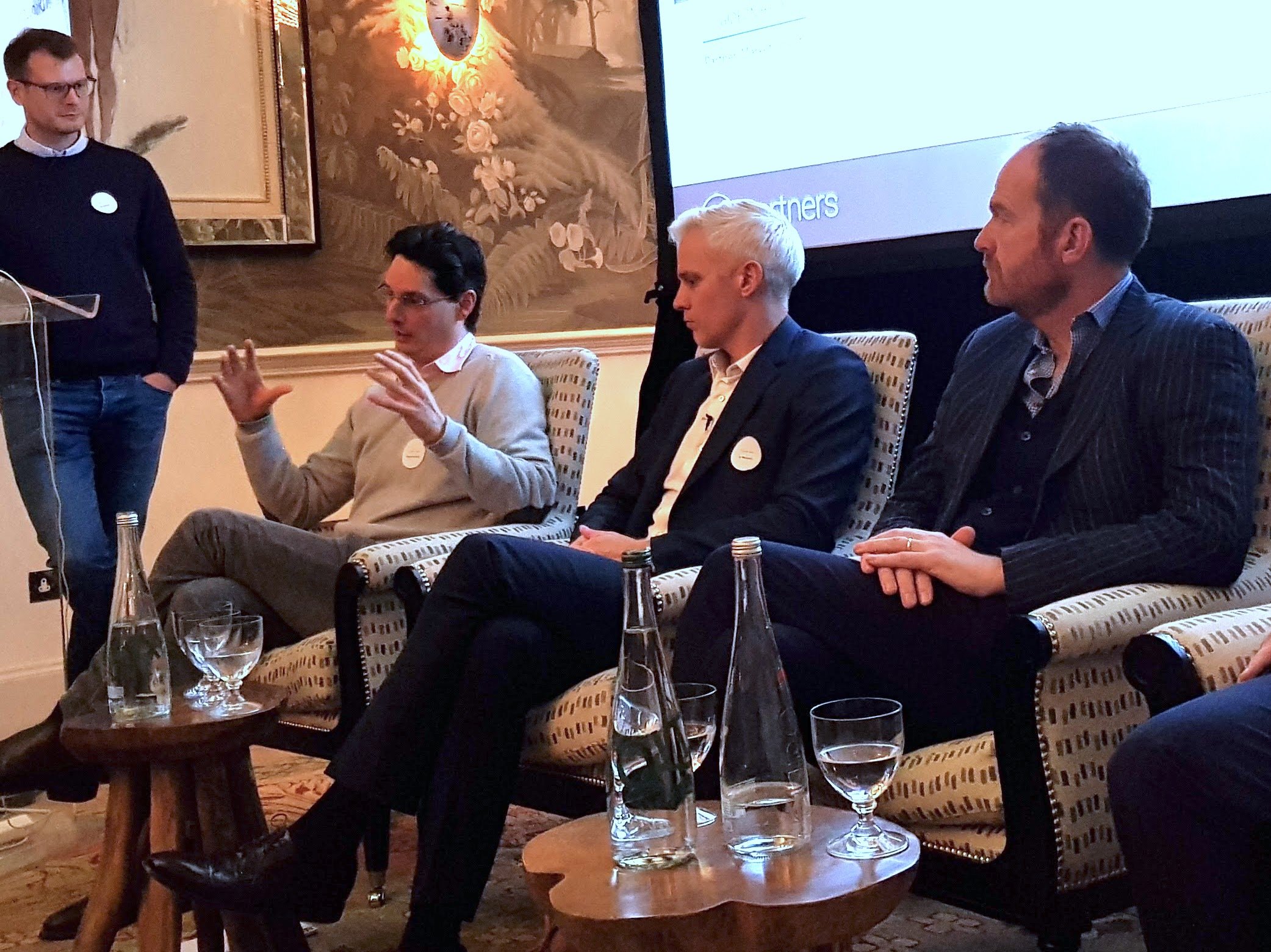Key takeaways from SI Partners’ Maximising Value event

Left to right: Matt Dymott Entourage BD, Gideon Hyde Market Gravity, Tristan Rice SI Partners, Andy Last Mullen Lowe salt, Karish Andrews Lewis Silkin discussing building equity value at Maximising Agency Value panel discussion.
Tristan Rice discusses M&A trends in the agency sector.
2017 has been another bumper year for entrepreneurs in this space. The agency landscape has become so much more complex over the last few years. Agencies used to fit into nice neat boxes like PR, Advertising, Direct Marketing and Media.
Now, digital platforms and technology have not only blurred the lines between agency disciplines; they’ve fundamentally changed what brands need from agencies – in terms of skills that cover all consumer touchpoints – and that means the agency landscape now extends way beyond marketing, into the broader customer experience.
And if you look to the not-too-distant future, it’s not hard to imagine that automation and machine learning will be as important to agencies as creative talent is today.
All this is driving huge disruption in our industry. But disruption creates opportunities, and opportunities tend to drive M&A. Investors and stakeholders of all stripes are trying to capitalise on, or protect themselves from this disruption by acquiring new skills and expanding into new markets.
And the fact is that the UK is a centre of excellence for many of these contemporary skills, so despite Brexit and a slowing wider economy, despite anti-globalisation, we’re seeing volumes of M&A that we really haven’t seen since the turn of the century.
The following summarises broadly who is buying what and why, and also outlines how much buyers are paying. If you would like to know more about M&A in a particular niche, please get in touch with Tristan.rice@sipartnersglobal.com for more detail.
Who’s buying what in the creative sector?
Consultancies:
About 18months ago I did a similar talk and I described them as being in experimental phase – dipping a toe in the water to see if adding design and creative skills to their offer made sense.
On paper it looks pretty logical. IT consultancies and professional services firms are helping companies to navigate digital disruption. A big part of that revolves around customer experience.
IT consultancies have reams of customer data & intelligence, but they don’t have the design, creative and communications skills to turn that into better, more engaging customer interactions. Professional services firms have the ear of the C-suite, but need to broaden their capabilities – particularly in terms of implementation – if they are going to retain and deepen those relationships.
And we’ve certainly seen a lot more acquisitions from consultancies this year. Accenture in particular has moved into a higher gear and is now busy filling in geographic gaps to develop a global creative offer. Cognizant has done some chunky deals – Mirabeau in The Netherlands, and a few weeks ago Netcentric in Germany, and Zone in London – some of the last big digital independents.
But before we get too carried away, it’s worth noting that consultancy acquisitions still represent a pretty small chunk of the deals in the overall agency space.
Of the 400 or so agency acquisitions that our research team analysed from 2016 to 2017, just 2% involved a professional services firm. IT consultancies were more significant and we’ll come on to those in a moment. (For the full analysis get in touch with nicole.revers@sipartnersglobal.com.)
Deloitte has been the most active but not yet on the scale that people had predicted. At one point this year there was a feverish rumour that they were about to buy The Engine Group, which obviously didn’t materialise.
And early movers like McKinsey, PwC, EY, KPMG, they’ve all bought relatively small digital design agencies over the last couple of years – but haven’t really tried to go beyond digital transformation and service design into the broader agency space.
Certainly in terms of the professional services firms, we don’t expect them to make a big push into marketing services in the near term. Apart from anything, it’s quite hard for some of them to make big acquisitions due to their partnership structure, which means they tend to distribute their profits rather than build up a warchest for M&A. And if they’re going to do marketing, it really needs to be on a pretty big scale to make it worthwhile.
What these professional services firms are really interested in at the moment are high value, strategic skills, that get them deeper into their global clients’ boardrooms and differentiate them from their peers. So I think we will see more deals likeDeloitte’s acquisition of Market Gravity. Perhaps in strategic advisory, research & insight and specialist capabilities for particular niches, geographies or sectors.
IT consultancies on the other hand are far more likely to threaten the marketing establishment – arguably they’re already doing that. As creative and technology become increasingly fused, it makes a lot of sense for IT consultancies to leverage their tech and data capabilities to drive more effective, efficient, engaging customer interactions; whether that’s through e-commerce and apps, CRM, marketing, even in-store.
Adding these capabilities also gives them new sales tools and a competitive advantage which can protect and enhance their multi-billion dollar legacy revenues in systems integration, software engineering, data, and so on.
So this is where I think we’re going to see the bulk of agency acquisitions. And in that respect, we’re probably only seeing the tip of the iceberg. There are a lot of big businesses in the IT consulting sector. Many have hardly got started in the agency space, but most of them are now talking to us and trying to work out what to buy, where and when.
Beyond digital design, which they’ve been acquiring for some time, highest priorities are likely to be content or digital marketing agencies – but really any discipline that can leverage their tech, systems and data could be a target.
There’s no indication so far that any of these consultancies has ambitions to plan & buy media for clients though. Even Accenture – the most aggressive of the pack – has said that the furthest they plan to go would be to build in-house trading desks for clients. So I think rumours of a consultancy buying one of the global holding companies are pretty far-fetched, as that’s where they make most of their money.
But as I said, despite all the press and gossip, the reality is that most agencies are still being bought by marcoms groups.
Emerging & evolving agency groups:
Probably the most active buyers in the UK at the moment are the emerging or evolving agency groups. Those that have the scale to service big brands, but are small enough to develop and combine their capabilities to provide the end-to-end solutions that clients want. Something that the holding companies struggle with due to their scaled siloes.
And there’s no shortage of investor appetite to support this – from both private equity and public markets.
Look at Be Heard Group for example. Over the last couple of years Peter Scott has raised 10s of millions on AIM and has been buying digitally-centric agencies from all disciplines – most recently a client of ours, The Corner – to create a new breed of full service agency.
Next 15, a more established group with a PR heritage, has bought about 5 agencies in the UK this year, in creative, brand experience, content marketing and research (Velocity and Elvis among them). Again, this is a response to the burring lines between disciplines and the demand from clients for more end-to-end solutions. Waggener Edstrom, or WE as it’s now called, is on a similar path.
Private equity has spotted the opportunity to turn around some of the flagging listed groups. We’ve seen both Chime and Creston taken private with a view to cutting out some of the dead wood and investing in new skills.
And there are plenty of other examples from around the world: You & Mr Jones and Stagwell from the US; kyu from Japan; Blue Focus from China; Enero from Australia.
To put this is context, of the 14 deals SI Partners completed in 2017, 8 have been to private or smaller listed marcoms groups.
Holding companies:
Not getting great press at the moment… But Martin Sorrell is on record saying that the threat from consultancies is exaggerated – and the reality is that the holding companies still own the vast majority of the trillion dollar marketing services sector.
So what are they up to? How are they responding to the changing industry and what are the implications for their M&A activity?
Well, they’re still reasonably active in fast-growing markets, but you may have noticed that they are buying fewer agencies in the UK than they used to. At one level that’s hardly surprising after a decade of buying up agencies of all kinds.
But there’s more to the story than that.
Firstly, there’s this increasing need to deliver more complete solutions. So for example, a PR agency needs to be able to create and distribute content across paid, owned and earned media. That brings them into competition, not just with other PR agencies, but with advertising, experiential, social and media agencies. That’s an awful lot of competing interests under one holding company roof.
Secondly, clients are becoming more cost-conscious. We’ve all seen the drive to increase profit margins across the FMCG sector especially. But as marketing performance becomes more measurable, clients can potentially get the same results with less money. That’s putting agency revenues and margins under increasing pressure.
Put these factors together and suddenly maintaining dozens of agency brands, many of which are increasingly competing with each other, does look a bit nuts…
But start merging some of these agencies, and you get two things: you get cost savings from back office synergies and management consolidation; and you also theoretically get the more integrated solutions that clients want.
We’ve seen evidence of this everywhere recently. WPP has just merged 5 of its design agencies; two of its media agencies, Maxus and MEC; as well as direct and digital agencies Wunderman and Possible. IPG did the same with Mullen and Lowe. Havas merged its creative and media businesses earlier this year.
So does this mean that the holding companies are no longer interested in buying independent agencies? Well no, not exactly. The independent sector still produces the most contemporary, disruptive agencies. It fosters entrepreneurial talent and new ways of working. If you’re going to put two agencies together, you probably need to add some of this magic dust things to make it work.
MullenLowe is a good case in point. Earlier this year MullenLowe acquired salt which added PR and strategic thinking to the mix. Then they bought 101, which beefed up their planning and creative leadership.
Another example is TBWA’s majority acquisition of Lucky Generals, which Omnicom hopes will revitalise an agency which has certainly seen better days in London.
The big groups also need to keep pace with the other buyer types I’ve mentioned. If they leave consultancies and smaller groups to buy up all the contemporary agencies, they’re going to be left behind pretty quickly. So despite the number of agencies they have already, we’re still seeing them compete for the top quality assets.
What has become noticeable though is that they are rarely the successful bidder for agencies that are in high demand. Perhaps the reputation of holding companies has become somewhat tarnished over the years. There are plenty of ex-agency owners around who haven’t enjoyed life after sale in a group environment.
Perhaps the strategic logic of sitting alongside loads of competing agencies looks rather less appealing when you have the opportunity to break new ground with a consultancy or innovative young group.
But there’s another major factor at play here. Which brings me on to the other topic I want to cover this morning.
How much are acquirers paying?
Over the last couple of years, as different buyers have come into the marcoms space, we’ve started to see more variation in deal structures – and more recently, some higher valuations.
Different types of buyer bring different cultures and economic models, and that tends to feed into their deal structures. If a buyer favours rapid integration, they’ll want a short earn-out period. That might mean total deal value is less overall than for a longer deal, but it may also be less risky, with a big chunk of the value paid up front and the rest over 1 or 2 years.
Smaller listed groups will often pay around a third of the value in stock, which preserves their cash, aligns everyone’s interests and acts as a lock-in mechanism for the selling shareholders.
But until recently, regardless of deal structure, the range of multiples used by different buyers tended to be broadly similar. Usually around 6x or 7x average EBITDA or pre-tax profit. Which makes sense, because buyers in the marcoms space are valued on average at around 8 to 10x EBITDA. So buying at 6 or 7 means the every deal adds value from day one.
But now we have consultancy and tech buyers in the mix. And you can see that their median valuations are significantly higher than marcoms buyers. That means that an agency acquisition can still add value at much bigger multiples than we’re used to seeing.
But as well as higher valuations, we’re also seeing a lot of consultancy deals based on multiples of revenue – sometimes between 2x and 3x, which can equate to around 13x to 15x EBIT.
Why are consultancies median valuations significantly higher than marcoms buyers?
There’s a strategic consideration. These consultancies are huge businesses that are scratching the surface of a new market. They’re buying agencies of maybe 2 or 300 people at most. For some, unless they can quickly turn that into 1,000s, it’s really a waste of time. It just won’t move the needle in their world. So their primary consideration at the moment is to establish a base for rapid future growth.
When Accenture bought Karmarama last year, which was about 250 people at the time, the question they asked them was, “If we bring you the clients, can you grow to 1,000 people in 2yrs?”. Expect them to start making acquisitions of their own to meet those targets…
So profit is a question for a later date. For now, the challenge is to build something of sufficient scale to make a difference. Basing valuation and an earn-out on a multiple of revenue can create a powerful incentive for growth.
For others, profits from agency services are pretty much irrelevant compared to the multi-billion dollar revenues they facilitate or protect.
Take Cognizant. They have an activist investor in the US that’s been pushing them to diversify away from legacy IT services into digital revenues. In the last year they’ve acquired 3 of the largest digital marketing agencies in Europe that were available to buy. And I can guarantee you that they have paid eye-watering multiples for them.
But this is a company with revenues of $14 billion. Their investors are happy; they have shiny new services to offer their clients which can act as a powerful sales tool – the tip of the spear as they say – for their core services. In that context, who really cares if they spent a few hundred million to make it happen?
So where does this leave the holding companies? Well, as I said, they can’t afford to let all the best assets get away, so the question is, will they match the prices being offered? That’s hard to imagine, but one can imagine that they will go beyond normal multiple range for digital assets.
Personally, I think Sorrell might be able to restructure WPP to stay competitive. We heard from their head office this week that they’re interested in acquiring management consultancies – so they’re not giving up without a fight. But I wouldn’t be surprised if a slower moving group like Omnicom is eventually acquired by Private Equity and broken up.
In the meantime, the good news for agency owners in the wider market – away from the highly sought after digital assets – is that one of the side effects of a lot more buyers in the market, is that we’ve seen inflation of multiples for agencies of all kinds.
So where we used to see pre-tax profit multiples topping out at around 7x EBITDA, now we quite often see multiples of 8 or 9x and sometimes into double figures.
Our general view is that valuations will eventually return to long term averages, as the new entrants become more established and start looking for cash returns on investment, but the market will look very different by then and creative will be firmly fused with technology throughout the industry.
Tristan Rice leads SI Partners global transactions team. For more information about creative sector M&A trends or for greater detail about M&A trends for a particular agency sector, get in touch with tristan.rice@sipartnersglobal.com.



